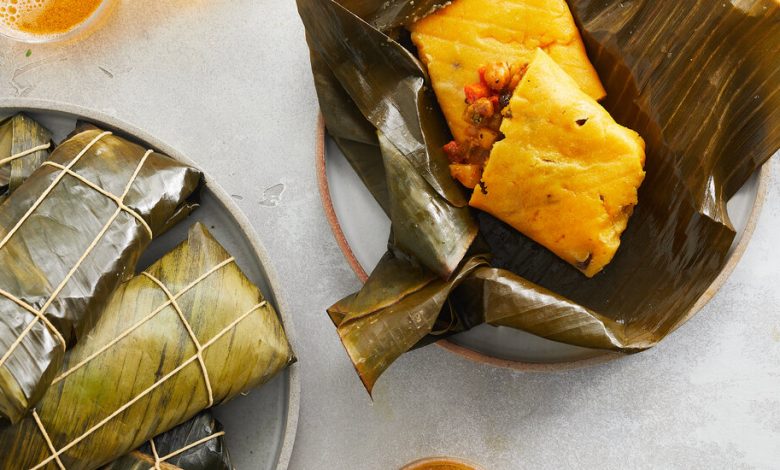For Venezuelans, Hallacas Are a Nostalgic Taste of Home

In 2015, the first year Héctor Arguinzones celebrated Christmas in the United States, he longed to share his mother’s hallacas with his wife, Niurka Meléndez, and their son, Samuel.
Hallacas, similar to tamales, are a signature dish of the holiday in Venezuela, where he and his family had emigrated from, but the only ones he could find in America were made with ketchup. So he spent the next couple of years learning how to replicate his mother’s recipe, taking cooking classes and having her decipher her vague measurements over long-distance calls until he finally nailed the filling.
Recipe: Hallacas
For Venezuelans at home and living in the United States, hallacas are a Christmas staple. Families spend several days making and assembling them, stuffing the guiso — the stewlike filling made from chicken, pork and beef and stained deep red from annatto — into corn masa. The hallacas look like presents when they’re wrapped in banana leaves and tied with cotton twine.
In 2017, Mr. Arguinzones and some friends cooked traditional holiday dishes like ensalada de gallina and pan de jamón for 200 Venezuelan immigrants in Harlem. Mr. Arguinzones made his mother’s hallacas.
Every year since then, over several weeks in December, he has continued to make them for 300 Venezuelan migrants in need over several weeks in December. On Dec. 22, the group gives them away, along with donated toys that Mrs. Meléndez has collected for each family.
“We do this to preserve our traditions,” Mr. Arguinzones said in Spanish. “When you’re eating that chicken salad, that hallaca, that pan de jamón, it’s going to feel like it was prepared like it is in your house.”
This is just one project that Mr. Arguinzones and Mrs. Meléndez plan under their organization, Venezuelans and Immigrants Aid. They started the group in 2016 to help Venezuelan migrants, more than 110,000 of whom have arrived in New York City since last year. In September, about 400,000 Venezuelan migrants throughout the country who entered the United States from March 2021 to July of this year were granted work permits.
Isbelis Diaz’s experience with hallacas was similar to that of Mr. Arguinzones. Ms. Diaz, who is from Maracaibo, recalls helping her mother and grandmother cut and peel vegetables that were going into the guiso along with pork. Her son, Ivo Diaz, pitched in to tie the hallacas tight.
She moved to New York in 2001, and soon after, began to make and sell hallacas, using her great-grandmother’s recipe from the 1930s. She built a following by bringing them to events and businesses (even to the owners of her local laundromat). She made hundreds during the holiday season.
Since 2019, Ms. Diaz has served her hallacas year-round at Casa Ora, the fine-dining Venezuelan restaurant she runs in Williamsburg, Brooklyn, with her son and daughter-in-law Rachel Diaz Pirard (the restaurant is named after her first granddaughter Ora Diaz). Two other cooks help her make the hallacas in an assembly line. On a recent Friday alone, they made 300.
“It’s a lot of work, but it’s never missing from the Venezuelan table,” Ms. Diaz said in Spanish.
Since 2010, Alejandro Hernández Padilla has been making his mother’s recipe for hallacas with his family in Pembroke Pines, Fla. He has used her handwritten grocery list to guide him.
In early December, he gathered with his father, wife, three children, sister, niece and other relatives to make the hallacas. They started by chopping the vegetables for the guiso throughout the week. On a Friday night, he made the guiso with chicken, pork, capers, onions, scallions and other ingredients. On Saturday, he set up stations where the team turned out 45 hallacas.
By 10 p.m., the family was eating freshly made hallacas.
“It takes me back to my childhood,” said Mr. Hernández Padilla, who grew up in Caracas. “This year, the kids are a little bit bigger so they helped a little more. Maybe one day they’ll remember when they used to make hallacas in the little house in Pembroke Pines.”
Follow New York Times Cooking on Instagram, Facebook, YouTube, TikTok and Pinterest. Get regular updates from New York Times Cooking, with recipe suggestions, cooking tips and shopping advice.





